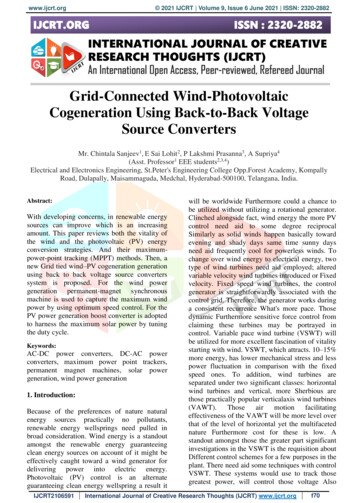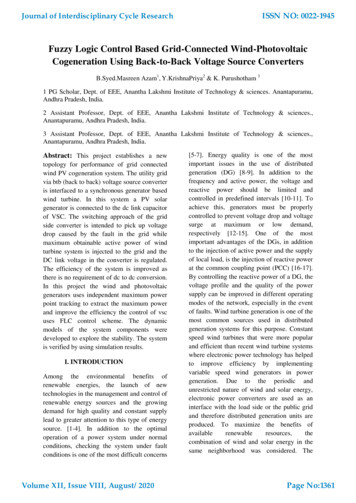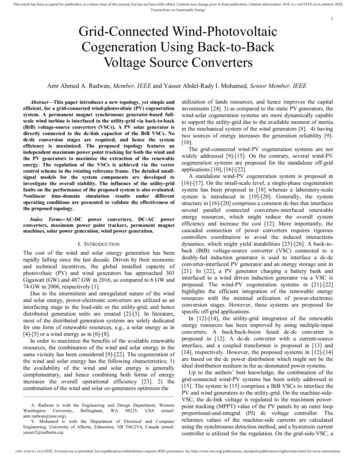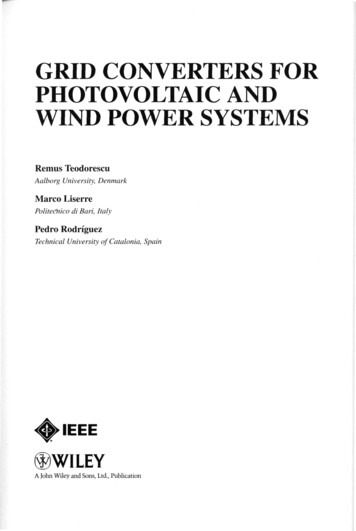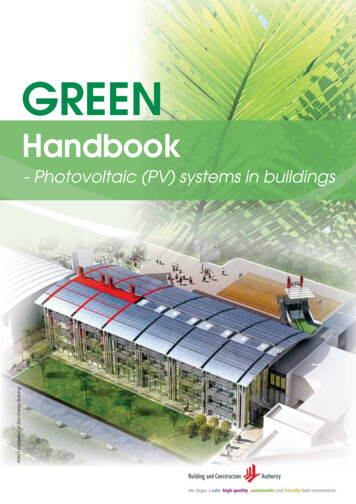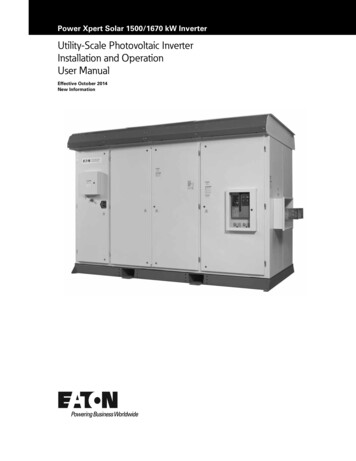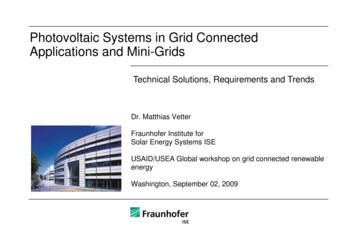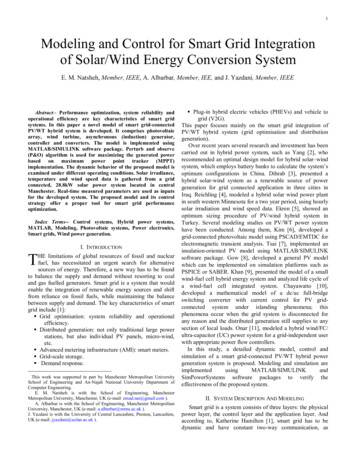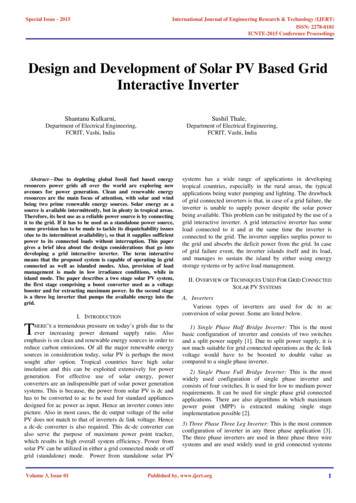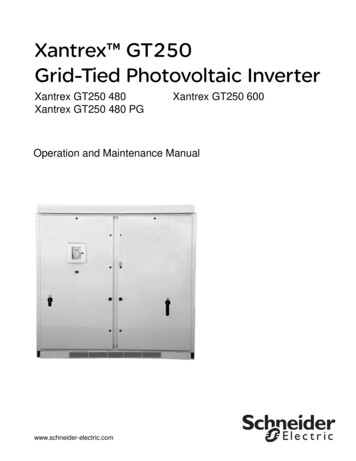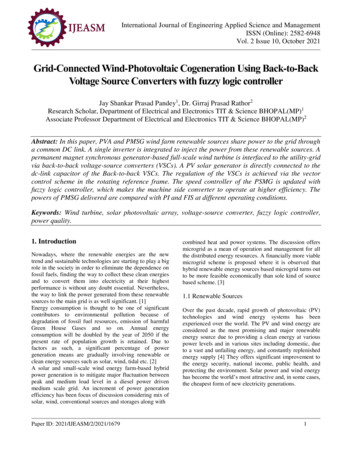
Transcription
International Journal of Engineering Applied Science and ManagementISSN (Online): 2582-6948Vol. 2 Issue 10, October 2021Grid-Connected Wind-Photovoltaic Cogeneration Using Back-to-BackVoltage Source Converters with fuzzy logic controllerJay Shankar Prasad Pandey1, Dr. Girraj Prasad Rathor2Research Scholar, Department of Electrical and Electronics TIT & Science BHOPAL(MP)1Associate Professor Department of Electrical and Electronics TIT & Science BHOPAL(MP)2Abstract: In this paper, PVA and PMSG wind farm renewable sources share power to the grid througha common DC link. A single inverter is integrated to inject the power from these renewable sources. Apermanent magnet synchronous generator-based full-scale wind turbine is interfaced to the utility-gridvia back-to-back voltage-source converters (VSCs). A PV solar generator is directly connected to thedc-link capacitor of the Back-to-back VSCs. The regulation of the VSCs is achieved via the vectorcontrol scheme in the rotating reference frame. The speed controller of the PSMG is updated withfuzzy logic controller, which makes the machine side converter to operate at higher efficiency. Thepowers of PMSG delivered are compared with PI and FIS at different operating conditions.Keywords: Wind turbine, solar photovoltaic array, voltage-source converter, fuzzy logic controller,power quality.1. IntroductionNowadays, where the renewable energies are the newtrend and sustainable technologies are starting to play a bigrole in the society in order to eliminate the dependence onfossil fuels, finding the way to collect these clean energiesand to convert them into electricity at their highestperformance is without any doubt essential. Nevertheless,the way to link the power generated from these renewablesources to the main grid is as well significant. [1]Energy consumption is thought to be one of significantcontributors to environmental pollution because ofdegradation of fossil fuel resources, emission of harmfulGreen House Gases and so on. Annual energyconsumption will be doubled by the year of 2050 if thepresent rate of population growth is retained. Due tofactors as such, a significant percentage of powergeneration means are gradually involving renewable orclean energy sources such as solar, wind, tidal etc. [2]A solar and small-scale wind energy farm-based hybridpower generation is to mitigate major fluctuation betweenpeak and medium load level in a diesel power drivenmedium scale grid. An increment of power generationefficiency has been focus of discussion considering mix ofsolar, wind, conventional sources and storages along withPaper ID: 2021/IJEASM/2/2021/1679combined heat and power systems. The discussion offersmicrogrid as a mean of operation and management for allthe distributed energy resources. A financially more viablemicrogrid scheme is proposed where it is observed thathybrid renewable energy sources based microgrid turns outto be more feasible economically than sole kind of sourcebased scheme. [3]1.1 Renewable SourcesOver the past decade, rapid growth of photovoltaic (PV)technologies and wind energy systems has beenexperienced over the world. The PV and wind energy areconsidered as the most promising and major renewableenergy source due to providing a clean energy at variouspower levels and in various sites including domestic, dueto a vast and unfailing energy, and constantly replenishedenergy supply [4] They offers significant improvement tothe energy security, national income, public health, andprotecting the environment. Solar power and wind energyhas become the world’s most attractive and, in some cases,the cheapest form of new electricity generations.1
International Journal of Engineering Applied Science and ManagementISSN (Online): 2582-6948Vol. 2 Issue 10, October 20211.2 Photovoltaic Array and Power GenerationPhotovoltaic systems can be sorted according to theirpower levels or based on system configuration or theconnection to utility grid. A typical PV system comprisesfour parts: the PV array, power conditioner, storagesystem, and PV inverter. Then the system is connected tothe utility grid with or without local load. Fig. shownbelow illustrates a basic PV system integrated with utilitygrid and local load [5]. Solar cells are combined in seriesto construct PV modules, converting solar energy toelectric power. PV modules can be combined in seriesand/or in parallel to assemble a PV array matching theelectric power demand.Figure Error! No text of specified style in document.1: Block diagramof basic PVconnections to provide enough electrical power for a givenapplication. Arrays range in power capacity from a fewhundred watts to hundreds of kilowatts. The connection ofmodules in an array is similar to the connection of cells ina single module. To increase the voltage, modules areconnected in series and to increase the current they areconnected in parallel. Matching is again very important forthe overall performance of the array. The structure of anarray is shown in figure, which has 4 parallel connectionsof 4 module strings connected in series. [5-6]1.3 Wind energyFor hundreds of years, people have used windmills toharness the wind’s energy. Today’s wind turbines, whichoperate differently from windmills, are a much moreefficient technology. In past windmills have been used forpumping water or grinding grain [7]. Today, the windmill'smodern equivalent - a wind turbine - can use the wind'senergy to generate electricity. Human resort to rely onwind turbines to extract energy from wind, electric powergeneration ones, as wind power is used to producemechanical energy in so-called windmills. Wind consideris a form of solar energy and nearly 2% percent of thesunlight that falls on the Earth's surface light turns intokinetic energy of the wind [8]. This is a huge amount ofenergy can be utilized to produce electrical energy. Windturbines, like windmills, are mounted on a tower to capturethe most energy. At 100 feet (30 meters) or moreaboveground, they can take advantage of the faster andless turbulent wind. [9]Wind turbine technology may look simple: the wind spinsturbine blades around a central hub; the hub is connectedto a shaft, which powers a generator to make electricity.However, turbines are highly sophisticated power systemsthat capture the wind’s energy by means of new bladedesigns or airfoils. Modern, mechanical drive systems,combined with advanced generators, convert that energyinto electricity. Wind turbines that provide electricity tothe utility grid range in size from 50 kW to 1 or 2 MW.Large, utility-scale projects can have hundreds of turbinesspread over many acres of land. [10]2. MethodologyFigure 2 Photovoltaic System ComponentsAn array is a structure that consists of a number of PVmodules, mounted on the same plane with electricalPaper ID: 2021/IJEASM/2/2021/1679The proposed system consists of a VSR to interface thewind generator, and a VSI to connect the cogenerationsystem into the utility-grid. The PV generator is directlyconnected to the dc-link capacitor of the BtB VSCs via adc cable. The VSR and VSI are two-level convertersconsisting of six cells; each comprises an insulated-gate-2
International Journal of Engineering Applied Science and ManagementISSN (Online): 2582-6948Vol. 2 Issue 10, October 2021bipolar transistor (IGBT) in parallel with a diode. In thefollowing subsections, the complete modeling and controlof the proposed system is provided.Figure 2 The proposed wind-PV cogeneration system3. Control Technique3.1 Fuzzy Logic ControllerThe DC side capacitor voltage must be measured andcompared to a reference value in order to implement thecontrol algorithm of a shunt active filter. Fuzzy processinghas two inputs: error and error change. The control actionof a fuzzy controller is determined by a set of linguisticrules. It has the advantage of not requiring a mathematicalmodel and working with erroneous inputs.[11-15].3.2 Advantages of Fuzzy Logic ControllerThe following are the benefits of fuzzy control over otheradaptive control methods:It shares output to input without much awareness of all thevariables, allowing for more precise system design. Thelanguage, rather than numerical, factors make the processresemble that of human thought. They are more resilientthan PI controllers due to their capacity to encompass alarge number of operational circumstances. FLC is cost-effective. FLC is adaptable. FLC is a trustworthy company. FLC is more efficient. It improves stability.The Mamdani fuzzy controller outperforms the PIcontroller; however, it comes with the drawback of ahigher number of fuzzy sets and rules. Additionally, inorder to surpass the typical PI controller, all of thecoefficients must be increased. The fuzzy control systemrequires less time to settle than the PI control system.4. Simulation Result & DiscussionA time-domain simulation model is developed under theMatlab/Simulink environment as shown in figure givenbelow to evaluate the validity and the performance of thesystem. The wind and PV generators are rated at 2.0 and0.9 MVA, respectively.Figure 4 Proposed system with PSMG wind farm and PVA moduleFigure 3 Block diagram of Fuzzy Logic ControllerPaper ID: 2021/IJEASM/2/2021/1679The above is the proposed test system with PMSGconnected to controlled rectifier. The rectifier is controlledby sinusoidal PWM generator with feedback from the3
International Journal of Engineering Applied Science and ManagementISSN (Online): 2582-6948Vol. 2 Issue 10, October 2021PMSG rotor speed. The grid side converter has feedbackfrom the solar irradiation which estimates the DC linkvoltage through MPPT generating the reference for thecontroller. The below are the three phase voltages andcurrent of the grid during renewable power sharing withvariable environmental conditions.Figure Error! No text of specified style in document. Grid three phasevoltagesFigure 6 Wind farm power comparison with PI and FIS controllersAs observed the power of the wind farm is more for fuzzylogic controller as compared to PI controller. The power isalso not recovered after the wind speed in back to normalafter some time in PI controller. The power of the windfarm is recovered to optimal value when the wind speed isback.5. ConclusionAs seen in the above results the powers form the PMSGwind farm and PVA are shared to the grid throughcommon DC link connected to single VSI. The VSR at thewind generator-side is responsible for extracting themaximum wind power following the wind speedvariations. On the utility-grid side, the roles of the VSI areto extract the maximum PV power from the PV generator,achieve the balance between the input-output powersPaper ID: 2021/IJEASM/2/2021/1679across the dc-link capacitor, and to maintain a unity PCCvoltage under different modes of operation.References[1] J. Ramakrishna, K. Rakesh, and T. A. Kumar,“IMPROVEMENT OF VOLTAGE PROFILE INHYBRID PV- WIND SYSTEM USING STATCOM,”vol. 9, no. 3, pp. 348–353, 2021.[2] S. Puchalapalli, S. K. Tiwari, B. Singh, and P. K. Goel,“A Microgrid Based on Wind-Driven DFIG, DG, andSolar PV Array for Optimal Fuel Consumption,” IEEETrans. Ind. Appl., vol. 56, no. 5, pp. 4689–4699, 2020,doi: 10.1109/TIA.2020.2999563.[3] F. Porté-Agel, M. Bastankhah, and S. Shamsoddin,Wind-Turbine and Wind-Farm Flows: A Review, vol.174, no. 1. Springer Netherlands, 2020.[4] H. Oussama, A. Othmane, C. Abdeselem, and H. M.Amine, “Wind turbine generator based on PMSGconnected to DC microgrid system,” vol. 7, pp. 40–43,2019.[5] N. K. Singh and D. Kumar, “A Review on WindTurbine and Wind Generator Used in WECS,” Int. J.Sci. Res. Sci. Eng. Technol., no. July, pp. 01–04, 2019,doi: 10.32628/ijsrset19635.[6] S. Ansari, “Assessment of Renewable Energy Sourcesof Iran,” vol. 6, no. 12, pp. 206–211, 2019.[7] A. Tekale, V. Ware, and V. Devkar, “Hybrid PowerGeneration by Solar & Vertical Axis Wind Turbine: AReview,” Ijireeice, vol. 6, no. 10, pp. 15–19, 2018, doi:10.17148/ijireeice.2018.6103.[8] S. Ma Lu, “Modelling, Control and Simulation of aMicrogrid based on PV System, Battery System andVSC,” Attrib. 3.0 Spain, no. January, p. 81, 2018,[Online]. Available: Google Scholar.[9] A. Muhtadi and A. M. Saleque, “Modeling andsimulation of a microgrid consisting solar PV & DFIGbased wind energy conversion system for St. Martin’sIsland,” 2017 IEEE 3rd Int. Conf. Eng. Technol. Soc.Sci. ICETSS 2017, vol. 2018-Janua, no. March 2018,pp. 1–6, 2018, doi: 10.1109/ICETSS.2017.8324152.[10] A. Muhtadi, “Solar PV & DFIG based Wind EnergyConversion System for St. Martin’ s Island,” 2017IEEE 3rd Int. Conf. Eng. Technol. Soc. Sci., 2017,[Online].[11] P. S. Sujay, W. M. M, and S. N. N, “A Review onFloating Solar Photovoltaic Power Plants,” Int. J. Sci.Eng. Res., vol. 8, no. 6, pp. 789–794, 2017, [Online].Available: http://www.ijser.org.4
International Journal of Engineering Applied Science and ManagementISSN (Online): 2582-6948Vol. 2 Issue 10, October 2021[12] P. S. U. Kulkarni and T. Gupta, “A Review on PMSGBased Wind Energy Conversion System,” vol. 2, no. 1,pp. 271–275, 2017.[13] K. M. Abo-Al-Ez and R. Tzoneva, “Active powercontrol (APC) of PMSG wind farm using emulatedinertia and droop control,” Proc. Conf. Ind. Commer.Use Energy, ICUE, vol. 2016-Octob, no. August 2016,pp. 140–147, 2016.[14] T. Khatib, I. A. Ibrahim, and A. Mohamed, “A reviewon sizing methodologies of photovoltaic array andstorage battery in a standalone photovoltaic system,”Energy Convers. Manag., vol. 120, pp. 430–448, 2016,doi: 10.1016/j.enconman.2016.05.011.[15] R. Prakash and S. Singh, “Designing and Modelling ofSolar Photovoltaic Cell and Array,” IOSR J. Electr.Electron. Eng., vol. 11, no. 2, pp. 35–40, 2016, doi:10.9790/1676-1102033540.Paper ID: 2021/IJEASM/2/2021/16795
peak and medium load level in a diesel power driven medium scale grid. An increment of power generation efficiency has been focus of discussion considering mix of solar, wind, conventional sources and storages along with combined heat and power systems. The discussion offers microgrid as a mean of operation and management for all
